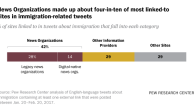Summary of Findings
Amid reports that BP has been able to at least temporarily stem the flow of oil from its ruptured underwater well, the public and the media last week again focused on the disaster in the Gulf of Mexico.

And, after several months of relentlessly bad news about the spreading spill, the possibility of a positive development appears to have registered with the public. Close to half (48%) say they have been hearing a mix of good and bad news about the situation in the Gulf, according to the latest weekly News Interest Index survey conducted July 15-18 among 1,003 adults by the Pew Research Center for the People & the Press. Only 18% say they have been hearing mostly good news, while 31% say they have been hearing mostly bad news.
More than half of the public (55%) say this was the news they followed most closely last week. The Gulf coast spill now has been the most closely followed story for each of the past 12 weeks.
News about the spill again received more coverage than any other major story, accounting for 20% of the newshole. That is up from 15% one week earlier, but still below peak levels reached in May and June, when it accounted for one-third or more of coverage, according to the Pew Research Center’s Project for Excellence in Journalism (PEJ).

On another subject, 40% say that – taking into account what they have read and heard so far about this year’s congressional elections – they think Republicans are more likely to gain a majority of seats in the House of Representatives than Democrats are to hold on to their majority (33% say this is more likely). More than a quarter (27%) say they do not know.
Democrats and Republicans offer widely different assessments, each favoring their own party. Among independents, 44% say they think a Republican takeover is more likely than Democrats holding on to their majority (25%). Partisan differences also are sharp when people are asked whether recent news coverage of certain political and party leaders – including Barack Obama and Sarah Palin – has been too tough, too easy or fair.
Judging the Tone of Recent Gulf News
After several months of news about failed efforts to stop the flow of oil into the Gulf of Mexico, BP appeared to make progress last week, installing a cap on the broken well on the ocean floor.

Among those following this news very closely – fully 50% of the public – a larger proportion (23%) says they are hearing mostly good news about the situation than among those following less closely (13%). Still, roughly the same numbers say they are hearing a mix of good and bad news (46% among those following very closely, 50% among those following less closely).
More of those 65 and older say they are following this news very closely (67%) than other age groups and more of those 65 and older say they are hearing mostly good news (26%). Those ages 18-29 are least likely to say they are following news about the Gulf oil spill very closely (35%). Among the youngest age group, just 14% see the news as mostly good. About a third in this group (35%) say the news has been mostly bad, compared with 23% of those 65 and older. Still, both groups are equally likely to say they are hearing a mix of good and bad news (50% for those 18-29 and 48% for those 65 and older).
On Balance, More See GOP Gaining Majority in House

Four-in-ten Americans say that from what they have read and heard about the upcoming congressional elections, they think it is more likely that the GOP will regain a majority of seats in the House than the Democrats will maintain their majority (33%). More than a quarter (27%) do not know.
The divide is wider among those following this news closely. Last week, the media devoted 6% of the coverage to the 2010 congressional elections, ranking that story just behind the oil spill and the economy. But fewer than two-in-ten (17%) say they followed these stories very closely and just 2% say they followed election news more closely than any other story.
More than half of those following news about the elections very closely (55%) say they think it is more likely that Republicans will win a majority of seats; 37% of those following less closely say this. There is no difference in the percentages that say the Democrats are more likely to hold their majority (34% among those following very closely; 33% among those following less closely), but those following less closely are much more likely to say they do not know (30% vs. 11%).
Among partisans, 74% of Republicans say that from what they have read and heard about the elections, their party is more likely to regain its majority. Six-in-ten Democrats (61%) say they think their party is more likely to maintain its majority. More than four-in-ten independents (44%), however, say they think it is more likely the GOP will win control; just a quarter say they think the Democrats will maintain their majority. More independents offer no opinion (31% don’t know) than either Democrats (18%) or Republicans (15%).
Partisans Take Differing Views on Fairness of Political Coverage
On balance, more Americans think news coverage of Barack Obama has been fair (39%) than too easy (27%) or too tough (24%). Those numbers are little changed since April. There continues to be wide partisan

differences in views of coverage of Obama. More than half of Republicans (55%) say the coverage has been too easy, 29% say it has been fair and just 8% say it has been too tough. Just 9% of Democrats say the coverage has been too easy, while equal percentages view it as fair and too tough (42% each).
Among independents, 44% see coverage of Obama as fair, 26% say it has been too easy and 20% say it has been too tough.
In assessing press treatment of Sarah Palin, more say the coverage has been too tough (30%) rather than too easy (18%); 32% say the coverage has been fair. In July 2009, 41% saw coverage of Palin as fair, 36% saw it as too tough and 12% saw it as too easy.
More than half of Republicans (53%) say coverage of Palin has been too tough. About a quarter say coverage has been fair (24%), while just 5% say it has been too easy. Three-in-ten Democrats, on the other hand, say coverage of Palin has been too easy, 37% say it has been fair and 16% say it has been too tough. Independents largely mirror the public as a whole.
Views of Coverage of Congressional Leaders, the Tea Party
The public tends to see coverage of both Democratic and Republican leaders in Congress as fair, while many do not offer an opinion on press coverage of the Tea Party movement.

Comparable numbers say coverage has been fair (45% for Republican leaders and 44% for Democratic leaders). About two-in-ten (22%) say coverage of Republican leaders has been too easy, while 15% say it has been too tough. For the Democratic leaders, 27% say coverage has been too easy and 12% say it has been too tough.
More than half of Republicans (53%) say coverage of Democratic leaders has been too easy; 27% say it has been fair and just 7% say it has been too tough. Looking at coverage of their own party’s leaders in Congress, 41% say coverage has been fair, 35% say too tough and 9% say too easy.
A majority of Democrats sees coverage of their party’s leaders as fair (54%), while 21% say it has been too tough and 11% say too easy.
Independents offer similar assessments of the coverage of both parties. About half (49%) say coverage of Republican leaders has been fair, 21% say too easy and 13% say too tough. Nearly half (48%) say coverage of Democratic leaders has been fair, 26% say too easy and 10% say too tough.
Many do not offer opinions about coverage of the Tea Party movement. Overall, 33% say coverage has been fair, 18% say too easy and 18% say too tough. About three-in-ten (31%) say they do not know.
Among Republicans, 33% say coverage of the Tea Party movement has been too tough, while 29% say it has been fair and 10% say too easy. Another 29% say they do not know. Among Democrats, 38% say coverage of the Tea Parties has been fair, 27% say too easy and 8% say too tough. About a quarter (26%) do not know. Among independents, 36% see coverage as fair, 18% say too tough and 16% say too easy. About three-in-ten (29%) offer no opinion.
The Week’s News
The oil leak and the economy’s continued struggles remain the top long-running stories of this summer. Close to four-in-ten (37%) say they followed news about the economy very closely, while 13% say this was the story they followed more closely than any other. News about the economy – not including final congressional action on a financial regulatory overhaul – accounted for 10% of the newshole, according to PEJ.
About a quarter (23%) say they followed news about the regulatory overhaul very closely; 4% say this was the story they followed most closely. News about the legi slation accounted for 5% of coverage.

Just more than two-in-ten (22%) say they followed news about the situation in Afghanistan very closely last week; 5% say they followed Afghanistan news more closely than any other story. News about the war accounted for 4% of coverage.
Fewer than two-in-ten (17%) say they followed news about the 2010 elections very closely. This was the top story for 2%. This news made up 6% of coverage. Meanwhile, 14% say they very closely followed news about a resolution passed by the NAACP calling on Tea Party leaders to condemn racist talk among supporters; 2% say this was the story they followed most closely. News about the Tea Party, primarily news about the NAACP resolution, accounted for 3% of coverage.
These findings are based on the most recent installment of the weekly News Interest Index, an ongoing project of the Pew Research Center for the People & the Press. The index, building on the Center’s longstanding research into public attentiveness to major news stories, examines news interest as it relates to the news media’s coverage. The weekly survey is conducted in conjunction with The Project for Excellence in Journalism’s News Coverage Index, which monitors the news reported by major newspaper, television, radio and online news outlets on an ongoing basis. In the most recent week, data relating to news coverage were collected July 12-18, and survey data measuring public interest in the top news stories of the week were collected July 15-18, from a nationally representative sample of 1,003 adults.
About the News Interest Index
The News Interest Index is a weekly survey conducted by the Pew Research Center for the People & the Press aimed at gauging the public’s interest in and reaction to major news events. This project has been undertaken in conjunction with the Project for Excellence in Journalism’s News Coverage Index, an ongoing content analysis of the news. The News Coverage Index catalogues the news from top news organizations across five major sectors of the media: newspapers, network television, cable television, radio and the internet. Each week (from Monday through Sunday) PEJ compiles this data to identify the top stories for the week. (For more information about the Project for Excellence in Journalism’s News Coverage Index, go to www.pewresearch.org/pewresearch-org/journalism.) The News Interest Index survey collects data from Friday through Monday to gauge public interest in the most covered stories of the week.
Results for this survey are based on telephone interviews conducted under the direction of Princeton Survey Research Associates International among a national sample of 1,003 adults living in the continental United States, 18 years of age or older, from July 15-18, 2010 (672 respondents were interviewed on a landline telephone, and 331 were interviewed on a cell phone, including 122 who had no landline telephone). Both the landline and cell phone samples were provided by Survey Sampling International. Interviews were conducted in English.
The combined landline and cell phone sample are weighted using an iterative technique that matches gender, age, education, race, Hispanic origin, region, and population density to parameters from the March 2009 Census Bureau’s Current Population Survey. The sample is also weighted to match current patterns of telephone status based on extrapolations from the 2009 National Health Interview Survey. The weighting procedure also accounts for the fact that respondents with both landline and cell phones have a greater probability of being included in the combined sample and adjusts for household size within the landline sample. Sampling errors and statistical tests of significance take into account the effect of weighting. The following table shows the error attributable to sampling that would be expected at the 95% level of confidence for different groups in the survey:

In addition to sampling error, one should bear in mind that question wording and practical difficulties in conducting surveys can introduce error or bias into the findings of opinion polls.




